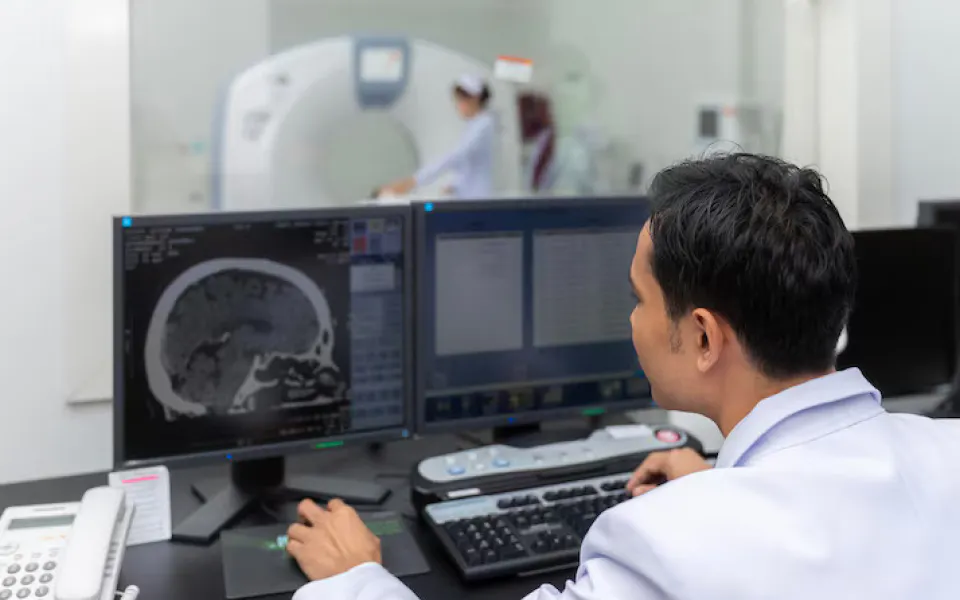In modern healthcare, Picture Archiving and Communication Systems (PACS) have revolutionized the way diagnostic imaging is managed. Moving away from traditional film based methods, PACS employs cloud based digital platforms that enhance the efficiency, security, and instant availability of medical images.
This guide offers a thorough overview of PACS, covering its history, benefits, common challenges in implementation, and future directions. It’s tailored for healthcare IT specialists, radiologists, and clinical administrators aiming to deepen their understanding of this vital technology.

What Is PACS?
PACS stands for Picture Archiving and Communication System a digital framework designed to securely store, retrieve, and distribute diagnostic imaging studies. By eliminating reliance on physical films, PACS enables clinicians to access X-rays, CT scans, MRIs, and ultrasounds anytime and anywhere within a healthcare network.
Often integrated with Radiology Information Systems (RIS) and Electronic Health Records (EHR), PACS automates workflows, reduces manual data entry, and ultimately contributes to improved patient care.
Save more and work smarter with Scriptoware’s cloud PACS.
Try Now !The Evolution of Radiology From Film to Digital
The Film Era
Traditionally, medical images were captured on physical film. This method was not only expensive and bulky but also posed logistical challenges, such as slow retrieval and complicated sharing processes, which impeded timely clinical decisions.
Early Digital Innovations
The late 20th century saw the arrival of Digital Radiography (DR) and Computed Radiography (CR), ushering in the era of digitized images. Initial PACS implementations digitized images but were often limited by on premises servers that restricted sharing capabilities and scalability.
Cloud Enabled PACS
Today’s PACS solutions leverage cloud computing to offer scalable storage, remote access, and heightened data security. Cloud PACS reduces the burden of on site infrastructure, accelerates image availability, and enhances interdepartmental collaboration, enabling faster diagnoses and more integrated care.
What Are the Costs Involved in Implementing PACS?
The expense of PACS deployment varies widely depending on factors such as the number of users, daily imaging volumes, feature requirements, and organizational scale.
Typical installation costs range from $50,000 up to several million dollars. These costs cover software licenses, necessary hardware, user training, system customization, and ongoing support.
For mid sized healthcare facilities seeking flexible pricing, Scriptoware’s Cloud PACS offers affordable monthly subscription plans starting at $499 (billed annually), balancing cost efficiency with robust functionality.
Experience Scriptoware Cloud PACS
Scriptoware’s Cloud PACS empowers medical professionals with secure, on demand access to imaging data from any location with internet connectivity. By replacing physical DICOM storage with cloud hosting, Scriptoware streamlines image retrieval and workflow efficiency.
The platform is designed to facilitate seamless remote collaboration among clinicians, making it an excellent tool for multi site hospitals and digital health services
Interested in seeing Scriptoware Cloud PACS in action?
Request your FREE demo today and discover how it can transform your imaging workflow.
Major Benefits of PACS for Medical Facilities
Immediate and Remote Image Accessibility
PACS empowers healthcare professionals to access diagnostic images from any location at any time, speeding up clinical evaluations and treatment planning.
Secure and Efficient Digital Storage
Moving beyond traditional film, PACS utilizes encrypted cloud based storage with frequent backups, reducing data loss risks and adhering to privacy standards like HIPAA.
Smooth Integration with Clinical Systems
By linking with Electronic Health Records (EHR) and Radiology Information Systems (RIS), PACS facilitates seamless retrieval of imaging data within patient files, reducing administrative burden and streamlining care delivery.
Accelerated Diagnostic Processes
Automating image management removes the delays caused by physical films, allowing radiologists to review images faster and improving overall patient care timelines.
Cost effective and space saving
Digital archives eliminate expenses related to physical film production and storage, freeing up valuable facility space once reserved for bulky archives.
Key Considerations When Implementing PACS
Initial Investment and Infrastructure Requirements
Though PACS can generate cost savings in the long run, the upfront costs may be substantial for smaller clinics. Cloud based PACS options present more flexible, budget conscious alternatives.
Data Protection and Compliance
Handling sensitive imaging data requires systems that comply with HIPAA and other regulations by employing strong encryption, user access controls, and reliable backup strategies.
Compatibility with Existing Hospital IT Systems
Integrating PACS with established hospital software such as HIS, RIS, and EHR may be challenging; ensuring interoperability is vital to maintaining workflow continuity.
Training and Adoption by Medical Staff
A successful PACS rollout depends on comprehensive education for radiologists, technicians, and support teams to maximize system utilization and effectiveness.
Discover Scriptoware’s DICOM Viewer
Our versatile DICOM Viewer is designed for effortless access to medical images across web browsers and mobile devices, securely hosted within the Scriptoware Cloud PACS platform.
Schedule a FREE demonstration now to explore Scriptoware’s full capabilities.
Emerging PACS Technologies to Watch
Artificial Intelligence Integration
AI is playing a growing role in PACS, assisting with automated image interpretation, anomaly detection, and workflow enhancements, leading to quicker and more accurate diagnoses.
Adoption of Cloud and Hybrid Models
Cloud based PACS systems offer scalable storage, reduced infrastructure costs, and facilitate collaboration across healthcare teams, even when spread across different locations.
Blockchain for Data Integrity
Exploring blockchain technology can further secure PACS data by providing immutable, tamper proof records, enhancing data trustworthiness and interoperability.
Mobile and Telemedicine Support
PACS platforms are evolving to support secure image access on mobile devices, enabling healthcare providers to deliver telehealth services with reliable imaging access anytime and anywhere.
What to Look for When Choosing a PACS Solution
When selecting a PACS provider, consider the following factors:
- Scalability: Can the system expand to meet increasing data and user demands?
- Integration: Does it connect efficiently with existing EHR, RIS, and hospital IT infrastructures?
- Security and Compliance: Are all relevant regulatory standards, such as HIPAA, fully met?
- Deployment Flexibility: What are the pros and cons of cloud based versus on premise installations?
- User Friendliness: Is the system intuitive and easy for clinical staff to operate?

Final Thoughts
PACS has revolutionized medical imaging by enhancing access, improving workflow efficiency, and safeguarding patient data. The future of diagnostic imaging is tied to innovations in cloud computing, AI driven tools, and telehealth integration.
Interested in a secure, scalable Cloud PACS?
Learn how Scriptoware Cloud PACS can streamline your imaging operations, enhance security measures, and improve patient care outcomes. Contact us today for further details!
Protect your scans and go future ready with Scriptoware’s free cloud PACS.
Try Now !